tow AUDI S4 CABRIOLET 2009 Owner's Manual
[x] Cancel search | Manufacturer: AUDI, Model Year: 2009, Model line: S4 CABRIOLET, Model: AUDI S4 CABRIOLET 2009Pages: 340, PDF Size: 77.32 MB
Page 178 of 340
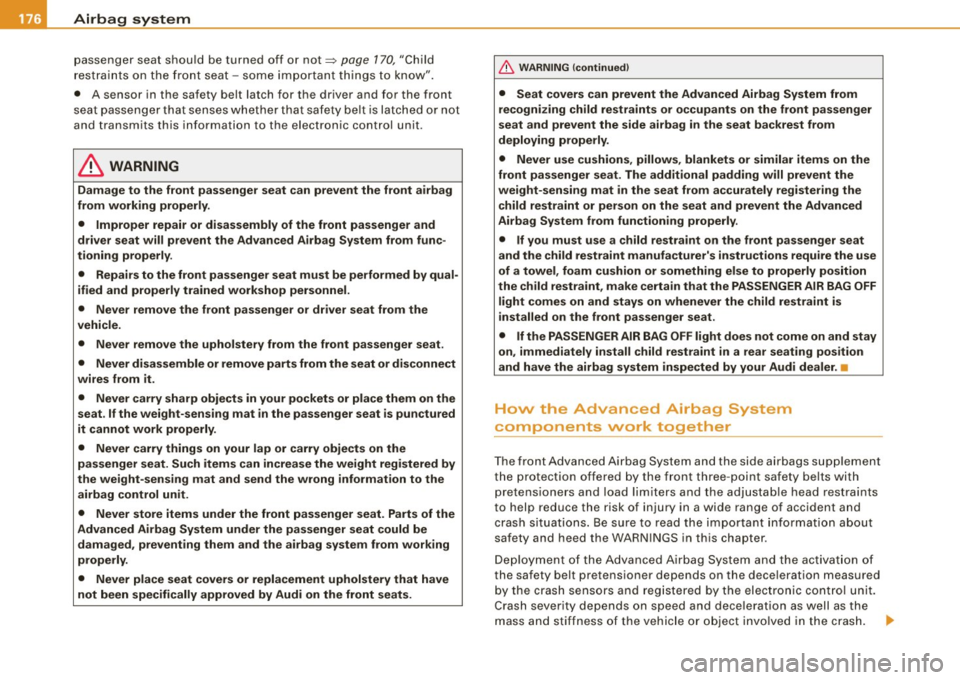
___ A_ ir_ b_ a~g _ s_ y_ s_ t _e_ m ___________________________________________________ _
passenger seat shou ld be turned off o r not=> page 1 70, "C hild
r es train ts on the fron t sea t - som e impo rtant thin gs to kno w".
• A sensor in the safety belt latch for the driver and fo r the front
s e at pass enger that s enses w hether tha t sa fety b elt is la tc he d o r no t
and transmits this information to the el ectronic control unit.
& WARNING
Damage to the front passenger seat can prevent the front airbag
from working properly .
• Improper repair or disassembly of the front passenger and
driver seat will prevent the Advanced Airbag System from func
tioning properly.
• Repairs to the front passenger seat must be performed by qual
ified and properly trained workshop personnel.
• Never remove the front passenger or driver seat from the
vehicle.
• Never remove the upholstery from the front passenger seat .
• Never disassemble or remove parts from the seat or disconnect
wires from it .
• Never carry sharp object s in your pockets or place them on the
seat . If the weight-sensing mat in the passenger seat is punctured
it cannot work properly.
• Never carry things on your lap or carry objects on the
passenger seat. Such items can increase the weight registered by
the weight-sens ing mat and send the wrong information to the
airbag control unit .
• Never store items under the front passenger seat. Parts of the
Advanced Airbag System under the passenger seat could be damaged , preventing them and the airbag system from working
properly.
• Never place seat covers or replacement upholstery that have
not been specifically approved by Audi on the front seats.
& WARNING (continued )
• Seat covers can prevent the Advanced Airbag System from
recognizing child restraints or occupants on the front passenger
seat and prevent the side airbag in the seat backrest from
deploying properly .
• Never use cushions, pillows, blankets or similar items on the
front passenger seat . The additional padding will prevent the
weight-sensing mat in the seat from accurately registering the
child restraint or person on the seat and prevent the Advanced
Airbag System from functioning properly.
• If you must use a child restraint on the front passenger seat
and the child restraint manufacturer's instructions require the use
of a towel , foam cushion or something else to properly position
the child restraint , make certain that the PASSENGER AIR BAG OFF
light comes on and stays on whenever the child restraint is
i nstalled on the front passenger seat .
• If the PASSENGER AIR BAG OFF light does not come on and stay
on , immediately install child restraint in a rear seating position
and have the airbag system inspected by your Audi dealer. •
How the Advanced Airbag System
components work together
The front Advanced Airbag System and the si de airba gs supp lement
t h e protection offe red by the front three -point safety be lt s with
pretensioners and load limiters and the adjustab le head restraints
to help reduce the risk of in jury in a wide range of accident and
cras h situati ons . Be sure to read the im por tant in fo rmati on a bout
safety and heed the WARN INGS in this chapter.
De ploy men t of the Advanc ed A ir b ag Syst em and the activa tion of
th e safety belt pretens ioner d epends on the dece leration measured
b y the c ra sh se nsors and reg istered by the elec tronic co ntrol un it .
C rash severity depends on speed and dece leration as well as the
mass an d stiff ness of the vehicle o r obj ect invo lved in the c ra sh.
~
Page 205 of 340
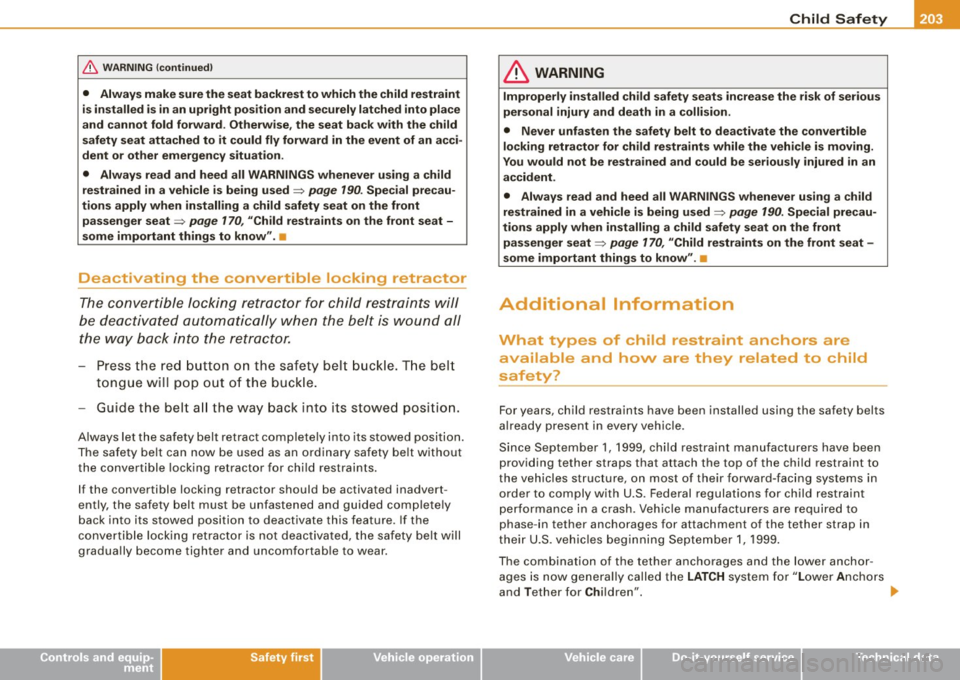
Child Safety IJ!III _________________________________ __:::...:....:...:..::.:......:__ ___ ....:.!.-__
& WARNING (continued )
• Always make sure the seat backrest to which the child restraint
is installed is in an upright position and securely latched into place
and cannot fold forward . Otherwise , the seat back with the child
safety seat attached to it could fly forward in the event of an acci
dent or other emergency situation .
• Always read and heed all WARNINGS whenever using a child
restrained in a vehicle is being used
=> page 190 . Special precau
tions apply when installing a child safety seat on the front passenger seat=>
page 170 , "Child restra ints on the front seat -
some important things to know ".•
Deactivating the convertible locking retractor
The c onver tib le l ocking retrac tor for ch ild res tra in ts will
be d ea ctivat ed automat ically wh en the belt i s wound all
th e way ba ck in to the retractor .
-Pre ss th e red bu tton o n the sa fety be lt bu ckle . Th e b elt
t o ngue will pop out of the b uck le .
- Guide the be lt all the w ay b ack in to i ts s to w ed p osition.
A lways l et t he safety belt retract complet ely into its stowed pos itio n.
T he safety belt can now be used as an ord inary safety be lt w ithout
t he conve rtibl e locking retractor for chi ld restrain ts.
I f the converti ble locking retractor should be activated inadvert
en tly, the safet y belt must be unf astened and guid ed completel y
back into its stowed pos ition to deactivat e th is feature. If the
c o nver tible loc kin g re tractor is n ot deac tiva te d , th e safe ty be lt wi ll
g radua lly becom e tighter and uncomfortab le to w ear .
Controls and equip
ment Safety first Vehicle operation
& WARNING
Improperly installed
child safety seats in crease the risk of serious
personal injury and death in a collision.
• Never unfasten the safety belt to deactivate the convertible
locking retractor for child restraints while the vehicle is moving .
You would not be restrained and could be seriously injured in an
accident.
• Always read and heed all WARNINGS whenever using a child
restrained in a vehicle is being used=>
page 190. Special precau
tions apply when installing a child safety seat on the front
passenger seat=>
page 170 , "Child restraints on the front seat -
some important things to know ".•
Additional Information
What types of child restraint anchors are
available and how are they related to child
safety?
F or years, chil d restraints have been installed using the safety belts
a lre ady pre s en t in ev ery ve hicle .
Sinc e Septem ber 1, 1999, c hild restraint manufactur ers have b een
providing tether straps that attach the top of the chi ld rest raint to
th e veh icles structure, on most of t heir forward -facin g syst ems in
order to com ply with U.S. Federal regulations for child restraint
per formanc e in a cras h. V ehi cle m anu fac tur ers a re r equi red to
phase -i n tether ancho rages for attach ment of the tether st rap in
their U.S. veh icles beginni ng Septem ber 1, 1999.
The combi nation of the t ether anc horag es and t he lower anchor
age s is now gene ra lly calle d th e
LATCH system f or "Lo w er An chors
and Tether for Children ". ..,
Vehicle care Do-it-yourself service Technical data
Page 218 of 340

___ ln_ te_ ll..,,ig ..,_ e_ n_t _t_ e_ c_ h _ n_o _ l_o _,.g= y,_ __________________________________________ _
& WARNING (continued)
• Do not "ride the brakes" by resting your foot on the pedal when
you do not intend to brake. This may cause the brakes to overheat, premature wear and increased stopping distance.
• Under certain climatic and operating conditions such as
passing through water, driving in heavy rain or after washing the
vehicle, the effectiveness of the brakes can be reduced. In winter,
ice can accumulate on the brake pads, linings, discs and drums .
Cautiously apply brakes for a test. Brakes will dry and ice coatings
will be cleaned off after a few cautious brake applications .
• Driving for an extended period of time on salt-covered roads
without using your brakes can also affect braking efficiency. Clean
off accumulated salt coating from brake discs and pads with a few
cautious brake applications.
• If you damage the front spoiler, or if you install a different
spoiler, be sure the air flow to the front brakes is not obstructed.
Otherwise the brake system could overheat reducing the effective
ness of the entire brake system.
• Failure of one brake circuit will impair the braking capability
resulting in an increased stopping distance. Avoid driving the
vehicle and have it towed to the nearest Audi dealer or qualified
workshop. u
Brake booster
The brake booster adds extra braking power.
The brake booster works with vacuum pressure which is created
only when the engine is running~ &.
& WARNING
• Never let the vehicle roll to a stop with the engine shut off.
• If the brake booster is not working, for example when towing
your vehicle, or because the brake booster has somehow been
& WARNING (continued)
damaged, the brake pedal must be pressed considerably harder to
make up for the lack of booster assistance. •
Functioning of Anti-Lock Brake System (ABS)
ABS prevents the wheels from locking up under braking.
The ABS contributes effectively to vehicle control since it prevents
the wheels from
locking when the brakes are applied. This means
that the vehicle remains steerable and is less likely to skid.
With ABS you do not need to pump the brake. Just hold the brake
pedal down.
However , do not expect that the ABS shortens braking distance
under
all circumstances. When driving on gravel or on newly fallen
snow on top of icy surfaces, braking distance may be even longer,
therefore, under these circumstances, it is especially important that
you drive slowly and with great care.
How the ABS system works
An automatic check is made when a speed of about 4 mph (6 km/h)
is reached. When this happens, a pumping noise can be heard.
If an individual wheel begins to rotate too slowly in relation to
vehicle speed and tends to lock, the ABS automatically reduces brake pressure to prevent that wheel from locking.
This automatic adjustment process will cause a
slight vibration of
the brake pedal and some noises to alert you that vehicle speed
must be adapted to existing road and traffic conditions.
& WARNING
Although the ABS is very effective, always remember that braking
capability is limited by tire traction . Always adjust your driving
speed according to the road and traffic conditions. Do not let the .,_
Page 220 of 340

___ ln_ te_ ll..,,ig ..,_ e_ n_t _t_ e_ c_ h _ n_o _ l_o _,.g= y,_ __________________________________________ _
• If the power steering system should fail entirely, or if the engine
is not running (for example, while being towed), you will still be able
to steer the vehicle . However, considerably more effort will be
required to do so.
• If the power steering system should have a leak, or is not func
tioning properly, contact your authorized Audi dealer immediately.
• The power steering system requires a specially formulated
hydraulic fluid. The power steering reservoir is the one located most
forward on the left side of the engine compartment=> page 251. The
correct fluid level in the reservoir is important for proper func
tioning of the power steering. •
Driving with your quattro®
With All Wheel Drive, all four wheels are driven.
General information
With All Wheel Drive, power is distributed to all four wheels. This
happens automatically depending on your driving style and the
road conditions at the time. See also=> page 213, "Electronic differ
ential lock (EDU".
Winter tires
When driving in the winter, your vehicle with All Wheel Drive has an
advantage, even with regular tires. In winter road conditions it may
be advisable to mount winter tires (or all-season tires) for improved
driveability and braking: these tires must be mounted on
all four
wheels.
See also => page 284, "Winter tires".
Snow chains
Where snow chains are mandatory on certain roads, this normally
also applies to vehicles with all -wheel drive => page 285, "Snow
chains".
Replacing wheels/tires
Vehicles with All Wheel Drive must always have tires of the same
size. Also avoid tires with different tread depths. For details see
page => page 279, "New tires and replacing tires and wheels".
Off-Road driving?
Your Audi does not have enough ground clearance to be used as an
off-road vehicle. It is therefore best to avoid rough tracks and
uneven terrain as much as possible. Also refer to=> page 221.
& WARNING
Always adjust your driving to road and traffic conditions. Do not
let the extra safety afforded by the all-wheel drive tempt you into
taking extra risks.
• Although the quattro®all-wheel drive is very effective, always
remember that braking capacity is limited by tire traction. You
should therefore not drive at excessive speeds on icy or slippery
road surfaces.
• On wet road surfaces, be careful not to drive too fast because
the front wheels could begin to slide on top of the water (hydro planing). If this should occur, you will have no warning from a
sudden increase in engine speed as with a front-wheel drive
vehicle. Always drive at speeds which are adjusted to the road conditions -risk of crash! •
Page 222 of 340

___ D_ r_i v_ in_,.. g"'- a_ n_ d_ e_ n_ v_i_r _o _n_ m_ e_n_ t _______________________________________________ _
New brake pads
Remember that new brake pads do not have a full braking
effec t during the first 250 miles (400 kilometers) after they
are installed .
New brake pads have to be "burn ished in" before they have optimal
grab =>& .
During the break -in period, you shou ld avoid putting severe loads
on the brakes . Severe loads include, for examp le, sudden hard
braking, in particular at very high speeds or, for example, on moun
tain passes.
& WARNING
Ne w brake p ad s don't h ave the bes t sto pp in g po we r and mu st b e
"brok en-in " durin g the initial 100 to 1 50 m il es ( 150 to 200 kil ome
t e rs) of norm al cit y dri ving . Y o u can com pensat e for thi s by
p re ss ing the br ake p ed al more firm ly. Th is also appli es later w he n
n ew pad s a re in sta lled.
:J
Catalytic converter
It is very important that your emission control system
(catalytic converter) is functioning properly to ensure that
y o ur vehicle is running in an environmentally sound
manner.
- Always use lead-free gasoline=> page 244, "Fuel supply".
- Never run the tank down a ll the way to empty.
- Never put too much motor o il in your engine =>
page 255,
"Adding eng ine oi l 'l:::r.11
•
- Neve r try to push -or tow -s ta rt yo ur vehic le.
The catalytic converter is an efficient "clean-up" device built into the
exhaust system of the vehicle. The catalytic converter burns many
of the po llutants in the exhaust gas before they are released into the
atmosphere.
The exc lusive use of unleaded fue l is critica lly important for the l ife
of the cata lytic converter and proper functioning of the engine.
& WARNING
• Do not p ark or op erate th e veh icle in are as w here the h ot
ex hau st sys tem m ay come in co ntac t w ith dr y gr ass, brush , fuel
s pill or other mater ial which can cau se a fire .
• Do not apply a dditi ona l u nder coating or ru stpr oofing on or
n ea r the exhau st m anifold , exhau st pipe s, ca ta lytic conv ert er or
h eat shie ld s. Dur in g d riving , the sub sta nce use d fo r und ercoa ting
coul d ove rhea t and cause a fire .
0 Note
• Be aware that just one tank filling with leaded fue l wi ll already
seriously degrade the performance of the catalytic converter.
• Do not exceed the correct engine oi l level =>
page 255.
• Do not drive until the fuel tank becomes comp letely empty . The
engine cou ld misfire. Unburned fuel could also get into the exhaust
system and this could cause the catalytic conver ter to overheat .
• Do not turn off the ignition while the vehicle is moving.
• Do not con tinue to operate your vehicle under these conditions,
as otherwise fuel can reach the cata lytic converter . This cou ld result
in overheating of the converter, requiring its rep lacement .
• To assure eff icient operation of the Em ission Control System:
- Have your vehicle maintained properly and in accordance with
the service recommendations in your Warranty
& Maintenance
booklet. •
Page 226 of 340
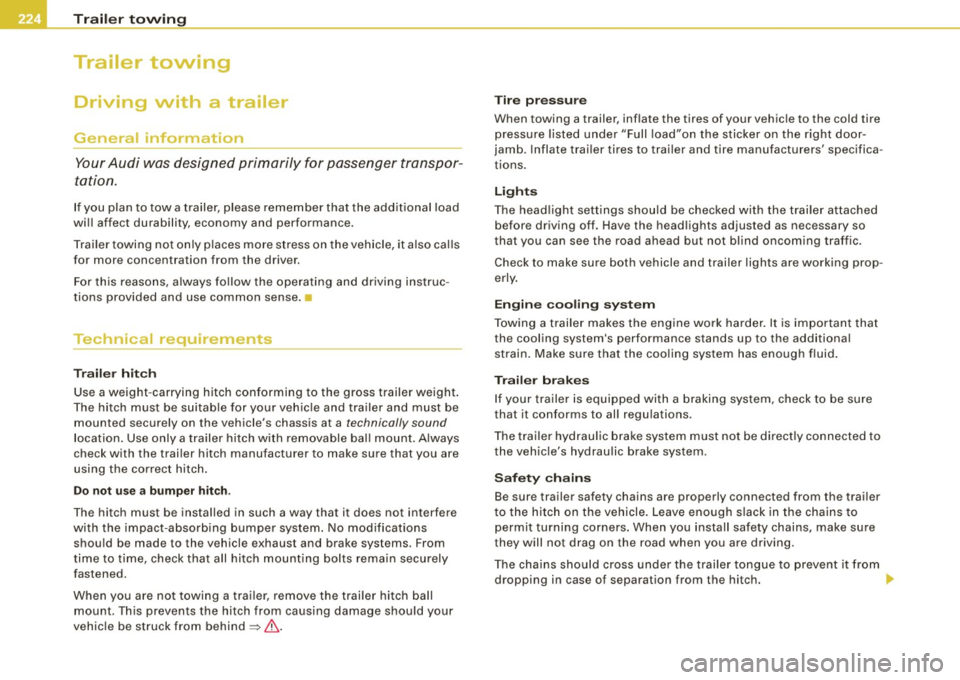
___ T_ r _a_ il_e _r_ t_ o_ vv_ in__... g,_ __________________________________________________ _
Trailer towing
Driving with a trailer
General information
Your Audi was designed primarily for passenger transpor
tation.
If you plan to tow a trailer, please remember that the additional load
will affect durability, economy and performance.
Trailer towing not on ly p laces more stress on the vehicle, it a lso calls
for more concentration from the driver.
For this reasons, always fo llow the operating and driving instruc
tions provided and use common sense. •
Technical requirements
Trailer hitch
Use a weight -carrying hitch conforming to the gross trailer weight.
The hitch must be suitab le for your veh ic le and tra iler and must be
mounted securely on the vehicle's chass is at a technically sound
l ocation. Use only a trailer hitch with removable bal l mount. A lways
check with the trailer hitch manufacturer to make sure that you are
using the correct hitch .
Do not u se a bumper hit ch .
The hitch must be installed in such a way that it does not interfere
with the impact-absorbing bumper system . No modifications
should be made to the vehicle exhaust and brake systems . From
time to time, check that all hitch mount ing bo lts re main securely
fastened.
When you are not towing a trai ler, remove the trailer hitch ball
mount. This prevents the hitch from causing damage shou ld your
vehic le be struck from behind
=:, & .
Tire pre ssur e
When towing a trailer, inflate the tires of your vehic le to the cold tire
pressure listed under "Full load"on the s ticker on the right door
jamb . Inflate trai ler tires to trai ler and tire manufacturers' specifica
tions.
Lights
The head ligh t sett ings should be checked with the trai ler attached
before driving off. Have the head lights adjusted as necessary so
that you can see the road ahead but not blind oncoming traffic.
Check to make sure both vehicle and trailer lights are working prop
erly .
Engine cooling sy stem
Towing a trailer makes the engine work harder. It is important tha t
the cooling system's performance stands up to the additional
strain. Make sure that the coo ling sys tem has enough fluid .
Trailer brakes
If your traile r is equipped wi th a braking system, check to be sure
that it conforms to all regu lations .
The trailer hydraul ic brake system must not be direct ly connected to
the vehic le's hydraulic brake system .
Safety chains
Be sure trailer safety chains are properly connected from the trai ler
to the hitch on the vehicle. Leave enough slack in the chains to
permit turning corners. When you install safety chains, make sure
they will not drag on the road when you are driving.
The chains shou ld cross under the trailer tongue to prevent it from
dropping in case of separation from the hitch.
~
Page 227 of 340
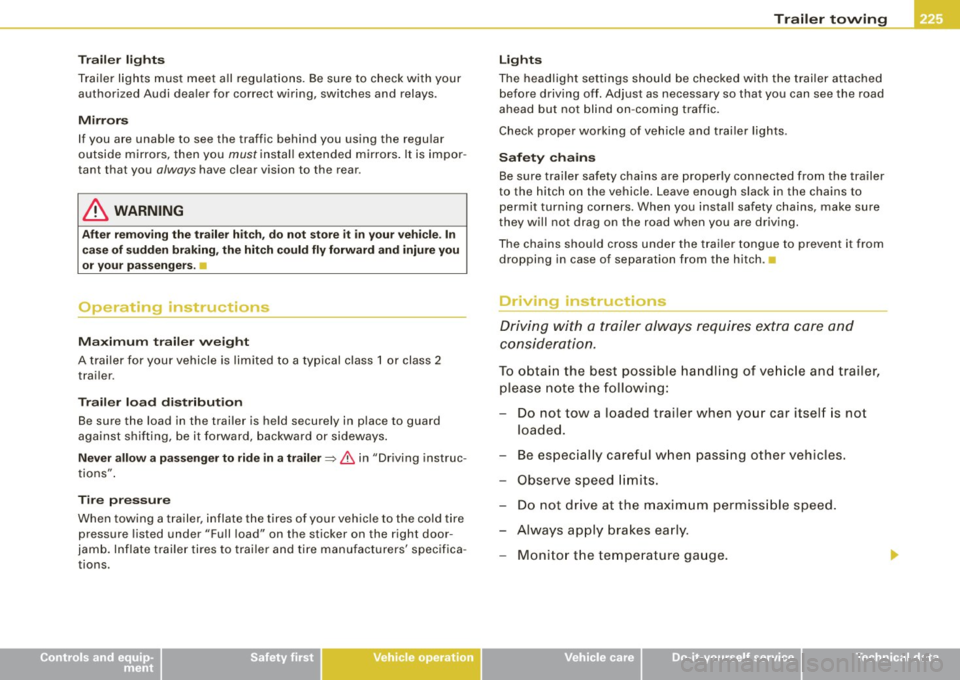
Trailer lights
Trailer lights must meet all regulations. Be sure to check with your autho rized Audi dealer for correct wiring , switches and relays .
Mirrors
If you are unable to see the traffic behind you using the regular
outside mirrors, then you
must install extended mirrors. It is impor
tant that you always have clear vision to the rear .
& WARNING
After removing the trailer hitch, do not store it in your vehicle. In
case of sudden braking, the hitch could fly forward and injure you
or your passengers .
.1
Operating instructions
Maximum trailer weight
A trailer for your vehicle is limited to a typical class 1 or class 2
trailer .
Trailer load distribution
Be sure the load in the trailer is held securely in place to guard
against shifting, be it forward, backward or sideways.
Never allow a passenger to ride in a trailer~&, in "Driving instruc
tions".
Tire pressure
When towing a trailer, inflate the tires of your vehicle to the cold tire
pressure listed under "Full load" on the sticker on the right door
jamb. Inflate trailer tires to trailer and tire manufacturers' specifica
tions.
Controls and equip ment Safety first Vehicle operation
Trailer towing
Lights
The
headlight settings should be checked with the trailer attached
before driving off. Adjust as necessary so that you can see the road
ahead but not blind on -coming traffic.
Check proper working of vehicle and trailer lights .
Safety chains
Be sure trailer safety chains are properly connected from the trailer
to the hitch on the vehicle. Leave enough slack in the chains to
permit turning corners. When you install safety chains, make sure
they will not drag on the road when you are driving.
The chains should cross under the trailer tongue to prevent it from
dropping in case of separation from the hitch .•
Driving instructions
Driving with a trailer always requires extra care and
consideration.
To obtain the best possible handling of vehicle and trailer,
please note the following:
Do not tow a loaded trailer when your car itself is not
loaded.
- Be especially careful when passing other vehicles.
Observe speed limits.
Do not drive at the maximum permissible speed.
- Always apply brakes early.
Monitor the temperature gauge.
Vehicle care Do-it-yourself service Technical data
Page 228 of 340
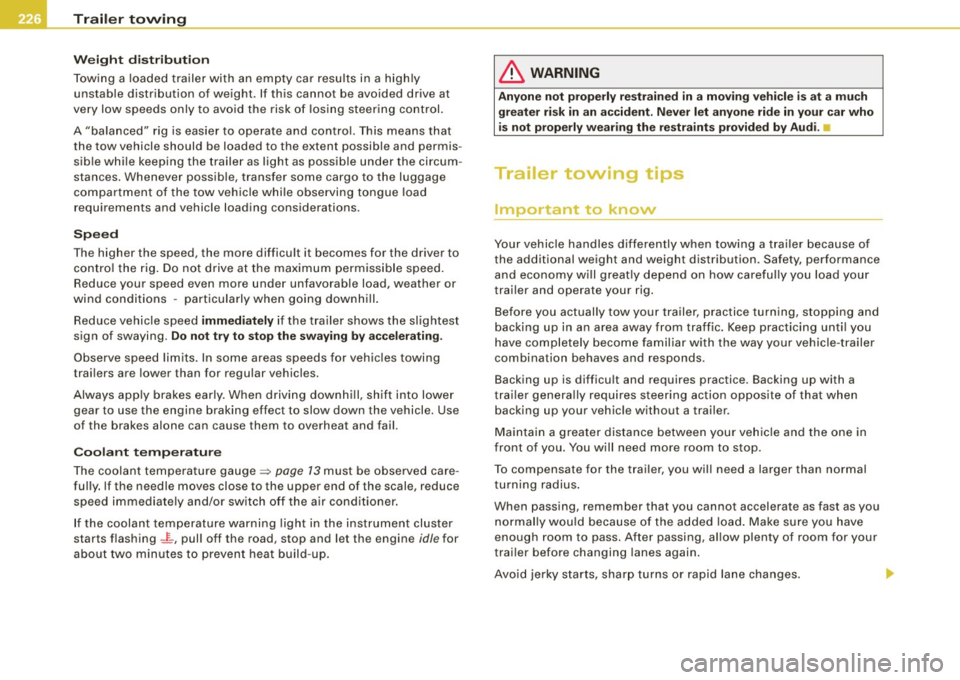
-Tr
aile r t owing ---=--------------
W eig ht dis tri buti on
Towing a loaded trailer with an empty car resu lts in a high ly
unstable distribution of weight . If this cannot be avoided drive at
ve ry low speeds only to avoid the risk of los ing steering control.
A "ba lanced" rig is easier to operate and control. This means that
the tow vehicle should be loaded to the extent possible and permis
sib le whi le keeping the trailer as light as possib le under the circum
stances. Whenever possible, transfer some cargo to the luggage
compartment of the tow vehicle while observing tongue load
requirements and vehicle loading considerations .
Speed
The higher the speed, the more difficult it becomes for the driver to
contro l the rig . Do not drive at the maximum permissible speed.
Reduce your speed even more under unfavorable load, weather or
wind condi tions -particularly when going downhill.
Reduce vehicle speed
imm ed iately if the trailer shows the slightest
sign of swaying.
Do not try to stop the s waying by a ccelerating .
Observe speed limits. In some areas speeds for vehic les towing
trai lers are lower than for regular vehicles.
Always app ly brakes early. When driving downhill, shift into lower
gear to use the engine braking effect to slow down the vehicle. Use
of the brakes alone can cause them to overheat and fail.
C oo lan t tem pe ra ture
The coolant temperature gauge~ page 73 must be observed care
fully. If the needle moves close to the upper end of the scale, reduce
speed immediately and/or switch off the air conditioner.
If the coolant temperature warning light in the instrument cluster
starts flashing -~- , pul l off the road, stop and let the engine
idle for
about two minutes to prevent heat build -up .
& WARNING
An yone not prop erl y r estr ained in a mo ving ve hic le is at a much
gre ater ri sk in an accident. N ever let an yone rid e in your car who
is not p roperl y wearing the r estraint s pro vid ed by Audi.
c
Trailer towing tips
Important to know
Your vehicle handles differently when towing a trai ler because of
the additional weight and weight distribution . Safety, performance
and economy will great ly depend on how carefu lly you load your
trai ler and operate your rig.
Before you actually tow your trailer, practice turn ing, stopping and
backing up in an area away from traffic. Keep practicing unti l you
have comp letely become familiar with the way your vehicle -trailer
combination behaves and responds .
Backing up is difficu lt and requires practice. Backing up with a
trailer genera lly requires s teering action opposite of that when
backing up your vehic le without a trailer.
Maintain a greater distance between you r vehicle and the one in
front of you. You will need more room to stop.
To compensate for the trailer, you wi ll need a larger than normal
turning radius .
When passing, remember that you cannot accelerate as fast as you nor mally wou ld because of the added load . Make sure yo u have
enough room to pass. After passing, allow plenty of room for your
trai ler before changing lanes again .
Avo id jerky starts, sharp turns o r rapid lane changes.
Page 229 of 340
![AUDI S4 CABRIOLET 2009 Owners Manual [ i ] Tip s
• Do not tow a trailer during the break-in period of your vehicle.
• If you tow a trailer, your Audi may require more frequent mainte
nance due to the ex AUDI S4 CABRIOLET 2009 Owners Manual [ i ] Tip s
• Do not tow a trailer during the break-in period of your vehicle.
• If you tow a trailer, your Audi may require more frequent mainte
nance due to the ex](/img/6/57654/w960_57654-228.png)
[ i ] Tip s
• Do not tow a trailer during the break-in period of your vehicle.
• If you tow a trailer, your Audi may require more frequent mainte
nance due to the ex tra load=>
page 316 . •
Parking on a slope
---'--------------------
Do not park with a trailer on a slope. If it cannot be
avoided, do so only after doing the following:
Wh en p arking :
-Apply the foot brake.
- Have someone p lace chocks under both the veh ic le and
the trailer wheels .
- Wit h chocks in p lace, s low ly release t he brakes until
wheel blocks absorb t he load.
- T urn t he wheels towards the curb .
- Apply the parking brake .
- Place an automatic transmission in
P , respect ively a
manual transmission in first or reverse gear.
Wh en restarting after p arking :
- Start the e ngine .
- Shift transmiss ion into gear.
- Re lease the parking brake and slowly pull out and away
from the w heel blocks.
- Stop and have someone retr ieve t he wheel blocks.
Controls and equip
ment Safety first Vehicle operation
Tr
aile r to wing
[ i ] Tip s
If you move the selector lever of the automatic transmission to P
before applying the parking brake and before blocking the wheels,
you may have to use more force later to move the lever out of the
P
position .•
Vehicle care Do-it-yourself service Technical data
Page 237 of 340
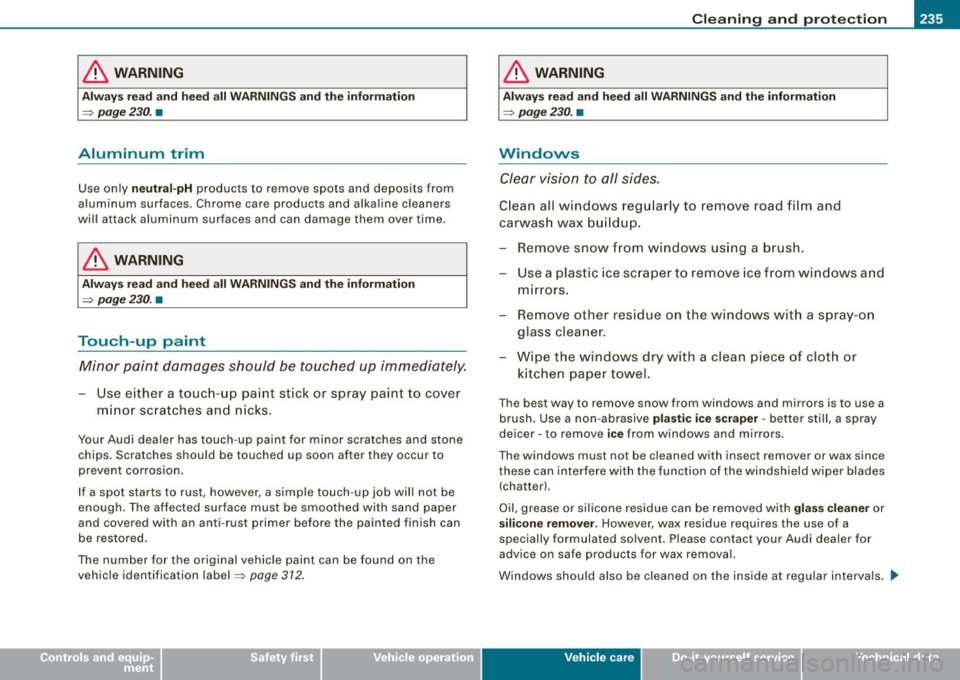
Cleaning and protection -
----------------
•
& WARNING
Always read and heed all WARNINGS and the information
~ page 230. •
Aluminum trim
Use only neutral-pH products to remove spots and deposits from
aluminum surfaces. Chrome care products and alkaline cleaners
will attack aluminum surfaces and can damage them over time.
& WARNING
Always read and heed all WARNINGS and the information
~ page 230 . •
Touch-up paint
Minor paint damages should be touched up immediately.
-Use either a touch-up paint stick or spray paint to cover
minor scratches and nicks.
Your Audi dealer has touch-up paint for minor scratches and stone
chips. Scratches should be touched up soon after they occur to
prevent corrosion.
If a spot starts to rust, however, a simple touch-up job will not be
enough. The affected surface must be smoothed with sand paper
and covered with an anti-rust primer before the painted finish can
be restored.
The number for the original vehicle paint can be found on the
vehicle identification label~
page 312 .
& WARNING
Always read and heed all WARNINGS and the information
~ page230. •
Windows
Clear vision to all sides.
Clean all windows regularly to remove road film and
carwash wax buildup.
Remove snow from windows using a brush.
- Use a plastic ice scraper to remove ice from windows and
mirrors.
- Remove other residue on the windows with a spray-on
glass cleaner.
Wipe the windows dry with a clean piece of cloth or kitchen paper towel.
The best way to remove snow from windows and mirrors is to use a brush. Use a non -abrasive
plastic ice scraper -better still, a spray
deicer -to remove
ice from windows and mirrors .
The windows must not be cleaned with insect remover or wax since
these can interfere with the function of the windshield wiper blades (chatter!.
Oil, grease or silicone residue can be removed with
glass cleaner or
silicone remover . However, wax residue requires the use of a
specially formulated solvent. Please contact your Audi dealer for
advice on safe products for wax removal.
Windows should also be cleaned on the inside at regular intervals. _,.
Vehic le care